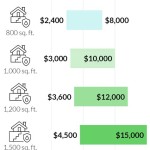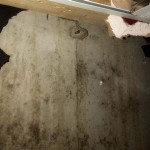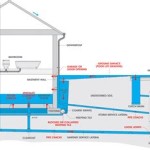The Best Rug Pad for Basement Floor: Protecting Your Rugs and Your Basement
Basement floors present unique challenges when it comes to flooring and rug placement. Often made of concrete, these floors can be cold, hard, and susceptible to moisture. Choosing the right rug pad for a basement floor is crucial to not only protect your rug but also to safeguard the underlying concrete from potential damage and improve the overall comfort and longevity of your flooring investment.
Numerous factors contribute to selecting the ideal rug pad for a basement environment. These range from material composition and thickness to moisture resistance and grip. A well-chosen rug pad will enhance the comfort underfoot, provide insulation against the cold concrete, prevent slippage, and promote airflow, mitigating the risk of mold and mildew growth. This article will explore the key considerations and the best types of rug pads for basement floors, ensuring a comfortable, safe, and long-lasting flooring solution.
The Importance of Moisture Resistance
One of the most significant concerns with basement floors is moisture. Concrete is porous and can absorb moisture from the ground. This moisture can then wick up into the rug, creating a breeding ground for mold and mildew. Consequently, a moisture-resistant rug pad is paramount. The ideal rug pad will act as a barrier, preventing moisture from reaching the rug and allowing for adequate airflow to promote drying.
Materials like felt combined with a moisture barrier or synthetic rubber are excellent options. These materials are designed to not absorb moisture and allow for ventilation. Open weave constructions can also be beneficial, facilitating airflow and preventing moisture from becoming trapped. It is crucial to regularly check the rug pad and the floor underneath for any signs of moisture accumulation, regardless of the pad's moisture-resistant properties.
The dampness and humidity often present in basements can also degrade the materials of the rug pad itself. Natural materials, unless treated, can be susceptible to mold and rot. Therefore, synthetic materials or treated natural fibers are preferred for their longevity and resistance to degradation in a basement environment. Investing in a high-quality, moisture-resistant rug pad is a proactive measure to prevent costly damage to your rugs and the basement floor itself.
Prioritizing Non-Slip Grip and Stability
Beyond moisture resistance, a secure grip is essential for a rug pad in a basement. Concrete floors can be slippery, especially when smooth or polished. Without a proper rug pad, the rug can easily slide around, posing a safety hazard, particularly for children and the elderly. A rug pad with a strong grip ensures the rug stays securely in place, preventing accidents and maintaining a neat appearance.
Several types of rug pads are designed with superior non-slip properties. One common option is a rug pad made from natural rubber or synthetic rubber with a textured surface. The texture creates friction between the rug and the floor, preventing slippage. Another effective design incorporates a waffle or grid pattern on one or both sides of the pad, providing enhanced grip. The tightness and density of the grid pattern are important factors to consider, as more dense grids often provide better grip, especially on smooth surfaces.
It is important to select a rug pad that is specifically designed for use on hard surfaces. Some rug pads are intended for carpeted floors and may not provide adequate grip on concrete. Reading product descriptions and reviews carefully will help ensure you choose a rug pad suited for your basement floor. Consider testing the rug pad's grip by placing the rug on top and attempting to slide it. This simple test can confirm whether the pad provides the necessary stability and prevents unwanted movement.
Choosing the Right Material and Thickness
The material and thickness of the rug pad significantly affect its performance and longevity. Different materials offer varying levels of cushioning, support, and moisture resistance. The appropriate thickness will depend on the rug's pile height, the desired level of comfort, and the intended use of the space.
Felt rug pads, often combined with a rubber backing, are a popular choice for basement floors. Felt provides cushioning and insulation, while the rubber backing offers moisture resistance and grip. The thickness of the felt can range from ¼ inch to ½ inch or more, depending on the desired level of comfort. Thicker felt pads provide more cushioning but may also raise the rug's profile, potentially creating a tripping hazard in high-traffic areas. A thinner felt pad might be more suitable in these situations.
Memory foam rug pads are another option, providing excellent cushioning and pressure relief. However, memory foam can trap moisture, so it is essential to choose a memory foam pad specifically designed for use in damp environments. These pads typically feature a moisture-resistant layer or an open-cell construction that allows for airflow. Latex or natural rubber rug pads are known for their durability and natural grip. These pads are eco-friendly and provide excellent cushioning and support. However, some individuals may be allergic to latex, so alternative materials should be considered in such cases.
Bonded fiber pads are constructed of recycled fibers that have been felted and needle-punched together to create a dense, supportive layer. Bonded fiber pads are typically more affordable than felt or memory foam options, but they may not provide as much cushioning. They still offer good protection for the rug and the floor and are a good choice for those on a budget. When selecting the thickness of the rug pad, consider the rug's pile height. A thicker rug pad may be appropriate for a low-pile rug, while a thinner pad may be better suited for a high-pile rug.
Considering Airflow and Ventilation
Promoting airflow underneath the rug is crucial for preventing moisture buildup and the growth of mold and mildew. A rug pad that restricts airflow can trap moisture, creating a damp environment that is conducive to microbial growth. Selecting a rug pad with an open-weave construction or ventilation channels can significantly improve airflow and reduce the risk of moisture-related problems.
Waffle-patterned rug pads are excellent for promoting airflow. The open spaces in the waffle pattern allow air to circulate freely under the rug, preventing moisture from becoming trapped. Grid-patterned rug pads similarly offer good ventilation, as the grid creates channels for airflow. When choosing a rug pad with a waffle or grid pattern, ensure that the pattern is dense enough to provide adequate grip and prevent slippage. Open-weave rug pads, made from materials like jute or synthetic fibers, allow for maximum airflow. However, these pads may not offer as much cushioning or grip as other options. They are best suited for low-pile rugs in areas with minimal foot traffic.
Regularly lifting the rug and rug pad to allow the floor to air out can also help prevent moisture buildup. This is especially important in basements that are prone to dampness. Using a dehumidifier in the basement can further reduce humidity levels and create a drier environment, minimizing the risk of mold and mildew growth. Inspecting the rug pad and the floor underneath periodically will help identify any signs of moisture. If moisture is detected, address the source of the moisture and allow the rug and rug pad to dry completely before replacing them.
Evaluating the Impact on Indoor Air Quality
The materials used in rug pads can affect indoor air quality. Some rug pads may release volatile organic compounds (VOCs), which can contribute to poor indoor air quality and potentially cause health problems. Choosing rug pads made from low-VOC or VOC-free materials is essential for creating a healthy indoor environment, especially in a basement, which may have limited ventilation.
Natural rubber rug pads are often considered a good choice for indoor air quality, as they are made from a renewable resource and typically contain fewer chemicals than synthetic materials. However, some natural rubber rug pads may still contain small amounts of VOCs. Look for natural rubber rug pads that have been certified by organizations like Greenguard or Oeko-Tex, which test products for VOC emissions. Felt rug pads made from recycled fibers are another eco-friendly option that can have a minimal impact on indoor air quality. Ensure that the felt is made from fibers that have been cleaned and treated to remove any potential allergens or irritants.
Synthetic rug pads, such as those made from memory foam or synthetic rubber, may contain VOCs. Choose synthetic rug pads that have been tested and certified for low VOC emissions. Look for products that are labeled as "low-VOC" or "VOC-free." Allowing the rug pad to air out for several days before placing it under the rug can help reduce any initial VOC emissions. Proper ventilation in the basement can also help improve indoor air quality and reduce the concentration of VOCs. Opening windows or using an air purifier can help circulate air and remove pollutants. Regularly cleaning the rug and rug pad can also help remove dust and allergens, further improving indoor air quality.
Determining the Right Size and Shape
Selecting the correct size and shape of the rug pad is crucial for proper fit and performance. The rug pad should be slightly smaller than the rug, leaving a small border around the perimeter. This allows the rug to lie flat and prevents the rug pad from being visible. An improperly sized rug pad can bunch up, create tripping hazards, and detract from the rug's appearance.
Measure the rug carefully before purchasing a rug pad. Subtract approximately 1-2 inches from each side of the rug's dimensions to determine the appropriate size for the rug pad. For example, if the rug measures 5 feet by 8 feet, the rug pad should be approximately 4 feet 10 inches by 7 feet 10 inches. Standard rug pad sizes are available for common rug dimensions, such as 5x8, 8x10, and 9x12. If the rug is an unusual size or shape, you may need to trim the rug pad to fit. Most rug pads can be easily cut with scissors or a utility knife.
Ensure that the rug pad is the same shape as the rug. For a rectangular rug, use a rectangular rug pad. For a round rug, use a round rug pad. Using a rug pad that is a different shape than the rug can create unsightly bulges or gaps. If the rug is a custom shape, such as an oval or a kidney bean shape, you may need to custom-cut a rug pad to match. Some retailers offer custom rug pad cutting services. When trimming a rug pad, make sure to cut it evenly and smoothly to avoid creating uneven edges. Use a straight edge or a template to ensure a clean, professional cut.

The Best Rug Pads Reviews By Wirecutter

Rug Pads For Concrete Basement Floors Rugpadusa

Rug Pads For Concrete Basement Floors Rugpadusa

The 7 Best Rug Pads Of 2024 Purewow

The Best Rug Pads Reviews By Wirecutter

Rug Pads For Concrete Basement Floors Rugpadusa

Rug Pads For Concrete Basement Floors Rugpadusa

Non Slip Rug Pad Options For Hardwood Flooring And More

Rug Pads For Concrete Basement Floors Rugpadusa

Non Slip Rug Pad Options For Hardwood Flooring And More







